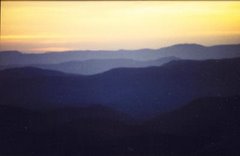december is finally here....so many wonderful things to look forward to; secret stockading of presents for those i love, cookie parties, brunches, concerts, decorating....oh my....it's kind of making me nervous thinking about it....

but as i sit here on the computer tending to my morning fire in the studio; i'm calmed....i woke up this morning and the house was so cold that it wasn't even registering on the thermastat...burrr....but as i started my fire this morning the ashes were still warm from the night, so i was comforted...
reading all reports about the upcoming winter; even dad's....it seems that we are in for the biggest winter/hardest - in over 100 years...there have been sightings of the 'black squirrel'...oh dear...and the man in the next town over - (who is really the closest to predicting)...says, yep, it's going to be a bad one...
reading all reports about the upcoming winter; even dad's....it seems that we are in for the biggest winter/hardest - in over 100 years...there have been sightings of the 'black squirrel'...oh dear...and the man in the next town over - (who is really the closest to predicting)...says, yep, it's going to be a bad one...
here is an article from the Jefferson Post, next town over...:
Joe Mullis doesn’t rely on televised weather forecasts or even the Farmer’s Almanac to tell him what Mother Nature has planned for the upcoming winter. He claims he already knows. In fact, it seems as if Mullis can tell up to four months in advance what each winter will bring to the High Country. He can determine the number of snows and severity of the winter before the first frost touches a blade of grass or the first cold snap grips the mountain counties.
What is his secret? A time tested calculation that he has practiced since he acquired the art from through oral tradition.“What we do and still do is something you might call a lost art or a dying art. We go by the way the Indians and old mountain people did. The real mountain people did. They were farmers who depended on nature to show them what each winter would be like,” Mullis said. “Mom has done it, grandma has done, and her grandma did it and so on. It’s something everyone did because they depended on it for their crops and livestock.

”His method is very simple. For each fog in August, Mullis drops a single bean into a canning jar. A larger fog denotes a big bean or a “big snow”, one that measures four inches or more of the white stuff. A lighter fog or bean represents a “little snow”, which provides just enough snow to cover the ground. At the end of August, Mullis counts the total number of beans, both large and small, to determine the total number of snows for the upcoming winter.

Mullis, an avid outdoorsman, also relies on a combination of other signs from nature to discern what Mother Nature is trying to tell him. In the months preceding each winter, Mullis examines the shape and thickness of the fall foliage. He analyzes the thickness of animal fur and even meticulously examines the thickness of blades of grass and how it lays. Insect and avian activity can also clue Mullis in to what he and others can expect.“Nature is always trying to tell us something. We just have to take the time to listen,” he said.
Some may scoff at Mullis’s method but it is hard to argue with results. In decades of prognosticating, he claims to have erred only twice. Both times he missed the number of correct snows by just one bean. Although Mullis is shooting well over 90 percent in forecasting winter weather, he is hoping that his streak will hit a dry spell with this year’s forecast.
After counting the beans from this past August, Mullis was shocked to discover 17 beans rolling around in the bottom of his counting jar. Nine of which were large beans and eight were smaller ones. “That’s the most beans we’ve had in a jar in years and years,” Mullis said.

While observing the local wildlife, Mullis discovered another ominous sign of both a bleak and harsh winter: a black squirrel. He has never seen a black squirrel before this year. This fall was actually the first time his 86-year-old mother, who follows the same guidelines as Mullis does in weather forecasting, has seen a black squirrel as well. Black squirrel sightings, Mullis explained, are synonymous for devastatingly harsh winters, unlike anything Ashe County has seen in the past century. “It’s the kind the Indians called the winter of sorrows,” Mullis said. “It’s going to come a little later than usual but it is going to stay long into spring. Spring is going to be a long time coming.”
Although Mullis has yet to experience a “black squirrel winter” he has learned through tradition and folk lore that one occurs once every hundred years. “I’ve heard that during the last one we had people nearly starved to death because food was so scarce and the winter was so hard,” Mullis explained.
.jpg)
being that most of our snow comes in february and march and often times april i have plenty of time still to stock up the shelves, freezer and buy more and more wood....



























2 comments:
I am ready for winter.... and *s*n*o*w*!!!
We have always counted the fogs in August for the snows in winter, too!
Have a lovely week Diane! :)
I'm here down in sunny Florida, it's 70 degrees today.....but I must say I am a bit jealous of the snow. Of course if I don't have to get up and go to work in it!!
Post a Comment